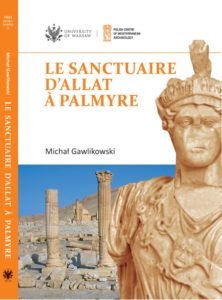-

-
Michał Gawlikowski, Le sanctuaire d’Allat à Palmyre (=PAM Monograph Series 8), Warsaw: PCMA UW, WUP, 2017
Warsaw 2017
ISBN 978-83-235-3493-8 (print)
ISBN 978-83-235-3501-0 (online)
https://doi.org/10.31338/uw.9788323535010
298 pages
Soft cover with flapsIn 1975, news of an exceptional discovery in Palmyra rapidly made the rounds within the scholarly community. Digging the ruins of a small sanctuary, archaeologists from the Polish Centre of Mediterranean Archaeology University of Warsaw uncovered a very well preserved statue of the goddess Athena, identified in Palmyra with the tribal goddess Allat. This Arabian deity did not hold a leading position in the Palmyrene pantheon, yet was deeply worshipped by the local Arab tribes.
The book by archaeologist Michał Gawlikowski, the excavator who made the discovery and lecturer at the University of Warsaw, eminent scholar and expert on Palmyra and its antiquities, brings an in-depth study of this statue, set in a detailed examination of the architectural evidence for the sanctuary itself, which existed from the 1st through the 4th century AD. The author reconstructs successive stages in the development of this cult place and the respective architectural decor. The volume, in French, is an excellent example of an interdisciplinary approach to the study of archaeological excavation data, compared and critically analyzed in the context of a discussion on epigraphic and numismatic sources, reaching also into the fields of art. history and religious studies.
For download:
Full Text (PDF)Reviews:
- Laurent Tholbecq (2020). Review of M. Gawlikowski, Le sanctuaire d’Allat à Palmyre. Varsovie, Polish Centre of Mediterranean Archaeology – University of Warsaw Press, 2017, L’Antiquité Classique 89, (in press)
“On saura gré à M. Gawlikowski d’avoir publié cette excellente monographie d’autant plus précieuse qu’elle livre des données et des interprétations désormais indispensables à l’étude des décors et des espaces religieux palmyréniens et proche-orientaux. On le remerciera aussi d’avoir choisi la langue française pour rédiger cette magnifique étude ; il s’inscrit en cela dans une longue tradition qui fait discrètement écho à tout ce que ce choix a pu signifier d’engagement et de foi en certaines valeurs, à une époque qui paraît, de toutes parts, aujourd’hui bien révolue.”
- Annie Sartre-Fauriat, Michał Gawlikowski, Le sanctuaire d’Allat à Palmyre, Syria [on-line], URL: http://journals.openedition.org/syria/8907
„Qu’il soit permis de répéter l’importance scientifique de cette publication sur l’un des temples de Palmyre qui, bien que n’ayant pas la même notoriété que ceux de Bêl ou de Baalshamin, n’en revêt pas moins une grande importance pour l’histoire du site et les pratiques religieuses de ses habitants.„
- Andreas Schmidt-Colinet, (2019). From Allat to Athena: Palmyrene architecture as an expression of cult, Journal of Roman Archaeology 32, 922–926
“With the publication of the Sanctuary of Allat we gain a new and deeper understanding not only of the architectural development of a single sanctuary but also of the development of the religious life of the ‘Caravan City’ within the historical process of ‘Romanisation’. Thanks to the detailed description and excellent graphic and photographic documentation of all the basic data, it is possible to follow up every step of the complicated archaeological evidence in the excavated area.”
- Aleksandra Kubiak-Schneider, « Michał Gawlikowski, Le sanctuaire d’Allat à Palmyre », Syria [on-line], URL : http://journals.openedition.org/syria/8914
“This book is not a simple final excavation report, but an attempt to understand the complexity of the ancient place of cult. It is a homage to the endangered world heritage exposed on brutal acts of violence against different religions and cultures in the name of an ideology.”
